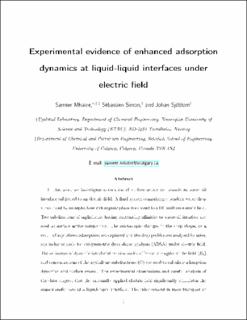| dc.contributor.author | Mhatre, Sameer | |
| dc.contributor.author | Simon, Sebastien Charles | |
| dc.contributor.author | Sjøblom, Johan | |
| dc.date.accessioned | 2020-09-29T06:48:04Z | |
| dc.date.available | 2020-09-29T06:48:04Z | |
| dc.date.created | 2020-09-14T13:23:17Z | |
| dc.date.issued | 2020 | |
| dc.identifier.issn | 0003-2700 | |
| dc.identifier.uri | https://hdl.handle.net/11250/2680088 | |
| dc.description.abstract | In this work we investigate adsorption of surface active compounds at water-oil interface subjected to an electric field. A fluid system comprising a pendent water drop surrounded by an asphaltene-rich organic phase is exposed to a DC uniform electric field. Two subfractions of asphaltenes having contrasting affinities to water-oil interface are used as surface active compounds. The microscopic changes in the drop shape, as a result of asphaltene adsorption, are captured and the drop profiles are analyzed by using our in-house code for axisymmetric drop shape analysis (ADSA) under electric field. The estimates of dynamic interfacial tension under different strengths of the field (E0) and concentrations of the asphaltene sub-fractions (C) are used to calculate adsorption dynamics and surface excess. The experimental observations and careful analysis of the data suggest that the externally applied electric field significantly stimulates the mass transfer rate at a liquid-liquid interface. The enhancement in mass transport at water-oil interface can be attributed to the axisymmetric electrohydrodynamic fluid flows generated on either sides of the interface. The boost in mass transport is evident from the growing decay in equilibrium interfacial tension and increased surface excess upon increasing strength of the applied electric field. The mass transfer intensification does not increase monotonously with the electric field strength above an optimum E0, which is in agreement with previous theoretical studies in the literature. However, these first explicit experimental measurements of adsorption at an interface under electric field suggest that the optimum E0 is determined by characteristics of the surface active molecules. | en_US |
| dc.language.iso | eng | en_US |
| dc.publisher | American Chemical Society | en_US |
| dc.relation.uri | https://pubs.acs.org/doi/10.1021/acs.analchem.0c01287 | |
| dc.title | Experimental evidence of enhanced adsorption dynamics at liquid-liquid interfaces under electric field | en_US |
| dc.type | Journal article | en_US |
| dc.type | Peer reviewed | en_US |
| dc.description.version | acceptedVersion | en_US |
| dc.source.journal | Analytical Chemistry | en_US |
| dc.identifier.doi | https://doi.org/10.1021/acs.analchem.0c01287 | |
| dc.identifier.cristin | 1829709 | |
| dc.relation.project | Norges forskningsråd: 255174 | en_US |
| dc.description.localcode | Locked until 7.9.2021 due to copyright restrictions. This document is the Accepted Manuscript version of a Published Work that appeared in final form in [JournalTitle], copyright © American Chemical Society after peer review and technical editing by the publisher. To access the final edited and published work see https://doi.org/10.1021/acs.analchem.0c01287 | en_US |
| cristin.ispublished | true | |
| cristin.fulltext | original | |
| cristin.fulltext | postprint | |
| cristin.qualitycode | 2 | |
